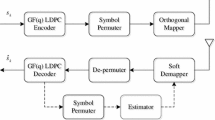Abstract
One great challenge in wireless communication systems is to ensure reliable communications. Turbo codes are known by their interesting capabilities to deal with transmission errors. In this paper, we present a novel turbo decoding scheme based on soft combining principle. Our method improves decoding performance using soft combining technique inside the turbo decoder. Working on Max-Log-Maximum a Posteriori (Max-Log-MAP) turbo decoding algorithm and using an Additive White Gaussian Noise (AWGN) channel model and 16 Quadrature Amplitude Modulation (16QAM), simulation results show that the suggested solution is efficient and outperforms the conventional Max-Log-MAP algorithm in terms of Bit Error Rate (BER). The performance analysis is carried out in terms of BER by varying parameters such as the Energy per bit to Noise power spectral density ratio (\(\text {E}_{\text {b}}/\text {N}_{\text {o}}\)), and decoding iterations number. We call our proposed solution Soft Combined Turbo Codes.











Similar content being viewed by others
References
Shannon, C. E. (1948). A mathematical theory of communication. Bell System Technical Journal, 27, 379–423.
Berrou, C., Glavieux, A., & Thitimasjshima, P. (1993). Near Shannon limit error-correcting coding and decoding: Turbo-codes. In Proceedings of IEEE international conference on communications (ICC), May 1993 (pp. 1064–1070). Geneva.
Berrou, C. (2007). Codes et turbocodes. Springer, France. ISBN 978-2-287-32739-1.
3rd Generation Partnership Project. (2008). Technical specification group radio access network, Evolved Universal Terrestrial Radio Access (E-UTRA), Multiplexing and channel coding (Release 8). 3GPP TS 36.212 V8.5.0.
3rd Generation Partnership Project. (2010). Technical specification group radio access network, Evolved Universal Terrestrial Radio Access (E-UTRA), Multiplexing and channel coding (Release 10). 3GPP TS 36.212 V10.0.0.
Wei, X., Guijun, H., & Qing, D. (2008). Application of turbo codes in optical ofdm multimode fiber communication system. Optics Communications, 281(5), 1118–1122.
Kahveci, S. (2012). Performance of the bluetooth system with bit-interleaved turbo coded modulation on interference channels. Digital Signal Processing, 22(6), 1113–1117.
Vilaipornsawai, U., Soleymani, M. R. (2001). Turbo codes for satellite and wireless ATM. In Proceedings of international conference on information technology: Coding and computing (ITCC), Apr. 2001 (pp. 120–124). Las Vegas.
Hagenauer, J., & Hoeher, P. (1989). A viterbi algorithm with soft-decision outputs and its applications. In Proceedings of IEEE GLOBECOM, Nov. 1989 (pp. 1680–1686). Dallas, TX.
Bahl, L., Cocke, J., Jelinek, F., & Raviv, J. (1974). Optimal decoding of linear codes for minimizing symbol error rate. IEEE Transactions on Information Theory, 20(2), 284–287.
Chaikalis, C., & Noras, J. M. (2004). Reconfigurable turbo decoding for 3g applications. Signal Processing, 84(10), 1957–1972.
Erfanian, J., Pasupathy, S., & Gulak, G. (1994). Reduced complexity symbol detectors with parallel structures for isi channels. IEEE Transactions on Communications, 42(234), 1661–1671.
Robertson, P., Hoeher, P., & Villebrun, E. (1997). Optimal and sub-optimal maximum a posteriori algorithms suitable for turbo decoding. European Transactions on Telecommunications, 8, 119–125.
El Makhtari, S., Moussaoui, M., & Samadi, H. (2012). Performance evaluation of AMC turbo coded OFDM for 3GPP long term evolution downlink system. In Proceedings of international conference on multimedia computing and systems (ICMCS), May 2012 (pp. 490–494). Tangier.
Samadiann, H., & Mousavie, Nia A. (2012). Linear-constant log-map, a fast accurate algorithm for map decoding. Journal of the Franklin Institute, 349(5), 1721–1733.
Cheng, J.-F., & Ottosson, T. (2000). Linearly approximated log-MAP algorithms for turbo coding. In Proceedings of IEEE vehicular technology conference (pp. 2252–2256).
Gross, W. J., & Gulak, P. G. (1998). Simplified map algorithm suitable for implementation of turbo decoders. Electronics Letters, 34(16), 1577–1578.
Papaharalabos, S., Sybis, M., Tyczka, P., & Takis Mathiopoulos, P. (2013). Novel generalized max* approximation method for simplified decoding of turbo and ttcm codes. Wireless Personal Communications Journal, 69(1), 373–386.
Enokizono, K., & Ochiai, H. (2010). A simple interleaver design for variable-length turbo codes. In Proceedings of 6th international symposium on turbo codes and iterative information processing (pp. 354–358).
Berrou, C., Graell i Amat, A., Ould-Cheikh-Mouhamedou, Y., & Saouter, Y. (2009). Improving the distance properties of turbo codes using a third component code: 3d turbo codes. IEEE Transactions on Communications, 57(9), 2505–2509.
Bhise, A., & Vyavahare, P. D. (2012). Modified turbo codes for next generation wireless networks. In Proceedings of 9th international conference on wireless and optical communications networks, Sept. 2012 (pp. 1–6). Indore.
Narayanan, K. R., & Stuber, G. L. (1997). A novel arq technique using the turbo coding principle. IEEE Communications Letters, 1(2), 49–51.
Chase, D. (1985). Code combining: a maximum-likelihood decoding approach for combining an arbitrary number of noisy packets. IEEE Transactions on Communications, 33(5), 385–393.
Yafeng, W., Lei, Z. & Dacheng, Y. (2003). Performance analysis of type III HARQ with turbo codes. In Proceedings of the 57th IEEE semiannual vehicular technology conference, Apr. 2003 (pp. 2740–2744).
Shi, Z., Ren, L.-Y. & Jin, F. (2002). Design and performance analysis of HARQ for RS-turbo concatenated codes. In Proceedings of IEEE international conference on communications, circuits and systems and west sino expositions, July 2002 (pp. 56–59).
Schlegel, C. (1997). Trellis coding. IEEE Press. ISBN 0-7803-1052-7.
Author information
Authors and Affiliations
Corresponding author
Rights and permissions
About this article
Cite this article
El Makhtari, S., Moussaoui, M. & Samadi, H. Improved Turbo Decoding Using Soft Combining Principle. Wireless Pers Commun 78, 1115–1127 (2014). https://doi.org/10.1007/s11277-014-1805-0
Published:
Issue Date:
DOI: https://doi.org/10.1007/s11277-014-1805-0




